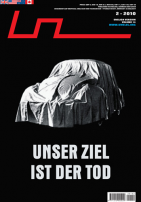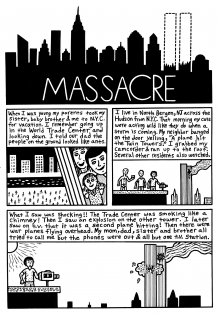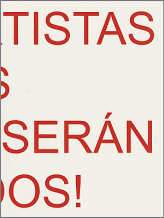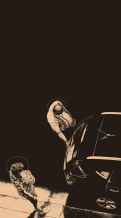| Umělec magazine 2010/2 >> What is a feminist now? Consumerism Capitalism Class and the Body | List of all editions. | ||||||||||||
|
|||||||||||||
What is a feminist now? Consumerism Capitalism Class and the BodyUmělec magazine 2010/201.02.2010 Lizzy Le Quesne | solutions | en cs de ru |
|||||||||||||
|
When, in my 2003 performance piece Shop Window, I invited the public to spend time with, and to photograph, naked women of widely varying ages in Gallery Václav Špála Prague, I was acting from a powerful gut-level instinct. This instinct came in direct response to the gender polarisation I saw on the streets around me, in the imagery of women which were littered across the billboards and advertising hoardings of Prague at that time. Oblivious to the products they were trying to sell, I experienced these images as a personal attack; on my self-esteem, on my hopes of relating to the rest of the culture and specifically to men, on my individual sensibilities, tastes, choices and desires. Gender inequality and gender polarisation are inherently related to capitalism and consumerism. It seems that even where a new generation of women have adopted the cause of feminism–or at least the word–the notion has become so servile to dominant consumerist values that it has lost its bite, its ability to question social systems and its essential meaning. The last month has seen two talks in London on the current state of feminism, one more radically political, at the Institute of Contemporary Art and the other more about personal experience and grass roots activism, at the Women’s Library. Both of them concluded that feminism is in crisis and called for it to be re-invigorated. The strongest voices at the ICA called for a new politicisation in terms of class, consumerism and capitalism. The best of the other meeting talked in terms of women joining forces in various ways, more or less formally, to be alert to the subtle sexism that they themselves are also implicit in, to grow in assertiveness and to find actual ways to promote other women. As a dance artist, I propose that energetic investigation into the subjective lived experience, rather than the image, of the body is another avenue for emancipation. The female body is appallingly commodified, but it is also an untapped and poorly understood site of potential influence, perception and subjectivity.
Czechs move fast Anyone who was in Prague in the summer of 2003 and during the first few years of our millennium will remember the beer advert showing a mug of froth-topped yellow liquid between the wide open, over-long legs of a woman wearing only an undersized black bra, and a host of similar images plastered across the city. They were eye catching, some comic, some even sexy, but they made me feel like crap. I needed to address this onslaught by commercial forces onto me and my kind. That ordinary women of a range of ages were to be viewed standing and moving, alongside shop mannequins and seen through the windows of the gallery–essentially and unequivocally within the commercial setting of a busy shopping street–was a central element of the concept of my performance project. This aspect was scuppered by the then director of the British Council (over-ruling his arts officer who had supported the project from the outset) when he became fearful of falling foul of a vague Czech law referring to ‘moral menace’ in the last few weeks of his headship. He insisted at the 11th hour that the women performers wear underwear, or that the event should be shielded from public view. Understanding that scantily clad women in a window could play into, rather than challenge, prevailing values of objectification, and that nudity was essential in terms of enabling both a sense of lived encounter with the body, and an awareness of the complexities around personal space, privacy, respect and trust, I eventually decided to cover the windows to force all of the viewers to enter inside the gallery space. In the event, I think this created a heightened palpability of the tension and confrontation between the viewer and the viewed in a lived exchange; which supported my work. Nevertheless, there seemed to me at the time an appalling irony between the capping of my humanist endeavour in the name of protecting ‘moral menace’, when every time that I stepped outside my door into public space it seemed I was affronted by an unchecked, publicly acceptable, trail of degradation, objectification and pornification of the female body, in the service of capitalist gain. When they hit, negative aspects of capitalist Western culture hit hard and fast across the former Eastern block. This was also the summer of Vít Klusák’s and Filip Remunda’s film Czech Dream which mercilessly exposed the new consumerism and language of advertising sweeping through the culture just then. Being a foreigner in Prague before and during that time, and able to observe this, was of personal use to me. Having experienced the same sudden expansion of consumerist values and the accompanying advertising in the UK in the 1980s as a teenager, then powerless to question it, it was a strange opportunity to revisit the process as an adult woman and revitalising to be able to actively respond with Shop Window. The impact of the project on ordinary Czech women was evidenced by Elle magazine receiving more readers’ letters and comments about their feature on that event than on any other article that year, and prompting a follow up piece some months later. When a New York academic later questioned the value of the project in a ‘post-feminist’ society I was amused. As a Czech curator and friend recently reminded me, “Czechs move fast”, and this period of ultra unchecked marketeering was relatively short lived and quickly re-balanced within wider western norms. Current advertising images in the Czech Republic are more subtle, as they are in the UK where I now live, but across the Western world they continue to reinforce an astonishingly narrow vision of human life etched firmly within the viewpoint of late capitalist ideology. They discourage free thinking, promote “uninformed irrational choices”1 and prolong both commodification of the female body and profound inequalities between the genders in a variety of social fields. Exploit yourself! A new wave of feminism is gathering momentum against any idea of equality as a completed project with popular books such as Natasha Walter’s Living Dolls: The Return of Sexism (2010) which vigorously attacks the new hyper-sexualisation of society and exposes the myth of it being supposedly empowering to women. Kat Banyard’s straightforward The Equality Illusion: The Truth About Women and Men (2010) presents statistics and personal accounts to illustrate how women are currently significantly worse off than men in many spheres of life. Banyard opened The Trouble With Feminism at the Institute of Contemporary Art by rejecting claims to post-feminism as a nonsense and affirming that “the struggle for equality between women and men has only just begun.” In the UK, she said, there are still 100,000 women raped every year, 1.5 million people with eating disorders–90% of them women–and only 22% of MP’s are women. The Equal Pay Act, passed in the UK parliament in 1975 was, she said, an abstract pledge that left women still paid 23% less than men and occupying the vast majority of part-time, low paid and unskilled jobs. Like Natasha Walter, she underlined new threats of our time as an unparalleled commercial sex industry and the “literal pornification of mainstream culture”. Nina Power, a wry, slumped and deviously charismatic Senior Lecturer in Philosophy at Roehampton University with unwashed hair continually falling into her face and wearing a fabulous yellow and grey, psychedelic, short sleeved jumper, went further, and spoke of how feminism itself has been colonised by a conservative, consumerist driven culture and is in dire need of re-politicisation and consideration in a broader context of capitalism. In the introduction to her book One Dimensional Woman (1999) she writes: “Did the desires of twentieth-century women’s liberation achieve their fulfilment in the shopper’s paradise of ‘naughty’ self-pampering, playboy bunny pendants and bikini waxes? That the height of supposed female emancipation coincides so perfectly with consumerism is a miserable index of a politically desolate time.” Power’s main thesis revolves around a re-considering of the current labour market along with a critique of contemporary sex and pornography, an attack on right-wing or prudish ‘moralist’ feminism and a call for a renewed leftist re-thinking of the nuclear family and social structures. In what she calls the “labourisation of women and the feminisation of labour”, she bemoans how women–and men—are increasingly exploited by the supposed freedom of short term and temporary contracts. In “the true horror of the contemporary world” she said at the ICA, “capitalism asks everyone to self exploit.” The economy replaces manual labour with service jobs which are mostly performed by women who–betrayed by a system which tells them they are emancipated to “buy vibrators and wine”–are caught in a constant state of having to appear bright, multi-skilled, capable and professional under the worst circumstances in terms of job security, rights, benefits, fulfilment, working relationships and so on. Similarly with sex, she implies, we are supposed to believe that getting lots of it, with or without a partner, is the mark of our new freedom, while it is becoming instead overly resolute, mechanical and “just another form of work.” She complains, in agreement with Ariel Levy’s Female Chauvinist Pigs: Women and the Rise of Raunch Culture (2005), that the aesthetics of sex has been narrowed and conformed, “the presentation of sex–both the emancipatory ‘feminist’ kind and the capitalist ad-selling kind–is remarkably homogeneous.” Regarding pornography, “almost any genre and type of sexual taste is catered for, just as long as you aren’t looking for anything as recherché as sweetness or wit.[...] What if there was another history of porn, one that was filled less with pneumatic shaven bodies pummelling each other into submission than with sweetness, silliness and bodies that didn’t always function and purr like a well oiled machine?” Women’s experience and behaviour must be looked at within specific social and economic contexts within a capitalist system, she insisted. Instead, a general moralism that is “often under investigated psychoanalytically,” she claimed, too often simply piles disapproval on–generally working class–women. In One Dimensional Woman she also critiques the moralist claim by right wing feminism of liberation for Islamic women in service of calls for war; and apparently suggests that calls for forced removal of the hijab are perhaps more about Western discomfort at a woman’s refusal to play to the dominant culture, to be seen–and open to objectification–than the rights of the woman herself. Indeed, in many ways the notion of wearing the burka is quite an attractive prospect – to flop on a floor length cloak (though perhaps not necessarily of black?) that covers you head to toe and simply removes one’s body from the barbed field of being seen and being judged–to turn the tables no less, by looking out at the world more than one is being looked at. Rather like women at the beginning of the twentieth century throwing away the corset in favour of the ‘Reform Dress’, or ‘housecoat’ of the Weiner Werkstatte, to give their bodies more space, comfort and freedom, or like Isadora Duncan, or Gustav Klimt for that matter, opting for long flowing robes beneath which they could allow their bellies to relax, their arms to raise and their legs to bend; a return to loose, whole body covering might for me I think, feel genuinely emancipating. Western women reveal amounts of flesh but seek privacy behind sunglasses. Devout Islamic women do the reverse, peeping out through the eye slit of the all-covering burka. Are we frustrated that another culture–Islam–provides the right to such privacy? Does the burka protect a realm of private space of and around the body–in the public realm–which angers, or terrifies our culture, that demands women to be available? Nina Power is extraordinarily pessimistic about the loss of private space and loss of private subjectivity that we experience in the current cultural and economic context. She goes so far as to claim that objectification (which implies an attacked subject) is already outdated. On sex, she says, “What if there is no longer a gap between an internal realm of desires, wants and fantasies and the external presentation of oneself as a sexual being?” and on work, and its requirement of constant accessibility and flexibility, “Objectification implies that there is something left over in the subject that resists such a capture, that we might protest if we thought someone was trying to deny such interiority, but it’s not clear that contemporary work allows anyone to have an inner life in the way we might once have understood it.” I do not entirely share Power’s pessimism here, though it is nevertheless relieving in a sense, to encounter it. Shop Window indeed emerged out of a vivid sense of the maddening inappropriateness of the public view enforced upon my all-too-evident-to-me-but-apparently-invisible-to-the-world private one. A middle class issue Acceptance and inclusion of the various real outer and inner identities of women were some of the things I hoped for with Shop Window, and were certainly the main things that resonated with Czech readers of Elle magazine. Ruth Holliday, Professor of Gender and Culture at the University of Leeds, spoke at the ICA about the ways that feminists have tended to judge other women. She listed various trends in a woman’s appearance that feminists have criticised as “leading men on”, such as ‘heroin chic’ or looking like a ‘porn star’. Holliday has examined this moralism and located it within the class system. She described her analysis of the position taken by middle class women of “natural is best” in their stance against plastic surgery, hair dye, cosmetics and so on. In the bible, Holliday said, being ‘natural’ means being passive and passive is good. Being ‘fake’, or making a specific effort to change something is being active; and active is bad. “What is it that has aligned modern feminism with the bible?” she asked. White middle class women, she said, believe in exercising restraint, self control, in being ‘respectable.’ “Patriarchy demands decorum, not exhibition.” And so, she argued, a gap can be perceived between a genuine stance of resistance and emancipation, and an old middle class, moralistic belief in the natural, “feminist positions are not middle class ones.” So we are caught between a society which objectifies, exploits and sexualises in the most simplistic sense, and a critiqued feminism which doesn’t in fact genuinely represent the rights of women as much as another older, patriarchal, moralistic standpoint! “The trouble with feminism,” said someone in the ensuing discussion at the ICA, “is that it’s a middle class issue.” The implication is that middle class women can, literally, afford to stand back and think about the issues. Although still thwarted in many ways compared to men–with secure homes, relative wealth, and the power of social connections and status–middle class women are vastly better off than working class women, and do not have to “sell themselves” in the same way. For working class women, the body is an effective currency and potential for exercising power in the culture as it currently exists. Middle class women are able, in the security of their other advantages, to retreat from the “front line” of the body, whereas working class women might need to exploit it as best they can. Thus breast implants, short skirts and whatever else can give women a little more status and visibility in the capitalist chain of events are used. For those without other options, there is always the last call of selling the body itself–in the sex industry. The less you have, the “nearer the knuckle” one gets in terms of one’s assets. Moralising against working class women for using what they can in a system which abuses all women is, Holliday revealed, more about long standing patriarchal Western values than women’s rights. At the Women’s Library, the discussion Feminism 40 Years On: Do We Still Need It? was less academic but equally passionate. Led by Women in Media, an activist group from the 1970’s, and attended by many members of London women’s groups, there was a lot of fascinating anecdotal history about women’s careers in print and TV media in the UK which was revealed as appallingly sexist, both past and present. These women were not critiquing capitalism itself but, functioning within the mainstream media, are working within its tightest grip. Anna Ford, Britain’s first woman TV newsreader and a leading feminist activist, quoted published articles in the national press that compared her body measurements to that of another woman presenter, or referred to her “worrying her pretty head” with women’s lib. At least twenty years younger, Bidisa, columnist at The Guardian, also vigorously described her experience of sexism within the arts, as an arts and culture reporter, highlighting the massive under-representation of women artists in the honours lists, publicity and promotional machines. “Women are not honoured in the art world” she said. In the current season, she pointed out, the National Theatre is showing nineteen plays, with only one of them by a woman, and of the ten new choreographers showcased at Sadler’s Wells (the UK’s leading theatre for contemporary dance) only three are women. She lists several more similar and worse stats across various art forms in terms of men and women featured in major UK prizes, commissions, festivals and reviews in her uncompromising Guardian article I’m Tired of Being The Token Woman. This includes an observation that looking back over the previous three months of The Sunday Times: “I realised they’d reviewed 17 books by men and one by a woman. Yet every day at work I receive packages in which women’s books outnumber those by men.” The system is horrifically stacked. In the Guardian, Bidisa wrote, “The establishment, patriarchy, the mainstream, whatever you want to call it, just doesn’t find women interesting. It makes sure that women are heavily outnumbered from the very beginning by offering us a fraction of available opportunities, slots, placements, commissions, trips, panel places, star jobs, reviews. Later it conveniently uses this to claim that there are not enough women ‘out there’ to make an impression higher up”. Additionally galling, she explained at the talk, is that, “It’s mostly women who go to the galleries, buy the books, recommend the shows to their friends and families and organise the trips. We are doing so much to value and support the arts, but whose careers are being helped? [...] Our energy is used to create an art world where our work is not rewarded.” And the victim is blamed, she said, in the notion that women do not push themselves appropriately, or that women do not support one another’s work enough. “Women working in arts and media are very compromised. We all feel the same but feel powerless.” She related how she suggested a significant woman author to her editor for a book review and was told “We did a woman last week” as the reason not to do it. “We fight sexism by night but have to support it by day” she complained. It’s genuinely shocking how ‘Othered’ women still are. Significance of body So our minds are not valued. But the world is excessively interested in our bodies. Somehow our bodies have been focused on, targeted, and most ‘othered’ of all, even from ourselves. Traditionally seen as primeval, irrational, vulgar and essentially fearful in the West, the body has been subjugated to the mind, in line with the way that women have been positioned in relation to patriarchy. In Writing on the Body: Female Embodiment and Feminist Theory (1997) Katie Conboy, Nadia Medina and Sarah Stanbury remind us that it was Simone de Beauvoir who “ultimately demonstrates that the self/other, man/woman, mind/body division provides the basis for all the binary oppositions so familiar to Western culture”. Capitalism too, exacerbates this, privileging the educated mind over the physical activity of the labourer and giving one the tools to control and exploit the other. And women have been understood as somehow more essentially dug into their embodiment than men. The facts of menstruation, pregnancy, childbirth and breastfeeding mean that a woman is unavoidably located in her body’s experience, and whether or not women actually have children; the reproductive function remains physically and emotionally a significant aspect of their lives. But somehow the Western world, and the workplace, has been set up to view this fact as essentially limiting women’s potential for being fully functional members of society. The Equal Pay Act and Sex Discrimination Act have done little to prevent maternity leave–or even the perceived possibility of it–seriously jeopardising women’s careers in the UK. Although employers are legally prevented from asking women outright at interview whether they have plans of becoming pregnant it is well known that this is the predominant reason for preferring to employ men on permanent contracts. “Women should not be penalised for having babies” said Anna Ford simply and very reasonably asked, “Whose babies do they have?” Yes, many women have babies. Yes, it is a massive experience for the body. Yes, it alters the mind-body relationship–acutely for a limited period, and permanently in subtler ways. But does it make us essentially less useful? Only in a society which is unable to acknowledge and support this experience within appropriate social and economic structures and a morality that essentially fails to value equality and difference. Seeing a pregnancy through to its end, the enormity of giving birth and then having a child to take care of has taken more blind faith, courage, diligence and selfless responsibility over an extended, seemingly endless, period than I have previously experienced. I am changed forever by it, and have valuable new perspectives, not in a way that reduces me. I am more grounded and centred and present than I had previously been. I have less time, but I waste less–on doubt and hesitation and procrastination. My instincts are strangely stirred, perhaps unearthing new complications, but in the service of understanding. I would argue that now in the time that I do have, I am of, if not greater, then certainly different and complimentary, value to the world than I was before. Mothers are privy to a fundamentally different outlook on life, humanity and society. So too are fathers, though society recognises the positives of fatherhood: assuming there will be a mother or someone forming a comfortable cushion between the child and the job. How many male politicians scuttle to bear a child in the path to power? How many female ones? Sarah Palin. In the UK employers assume that mothers (and all women are either potential mothers or embittered and childless) will have less interest and commitment to their jobs than men, or than they did before they got pregnant. Even if this were so, which I know from personal experience it isn’t, employers should be forced to treat women more fairly across the board. Women are no more embodied than men, but with the reality of childbirth, and the imposition of patriarchal, capitalist culture that objectifies them, they may be more connected to and identified with their bodies. The body itself has been traditionally feminised in Western culture, but a wealth of research from phenomenology to psychology, to linguistics and neuroscience is radically challenging Cartesian Dualism and revealing what instinct and alternative medicine and thinking have known all along: how profoundly inter-related and interdependent mind and body are. Johnson and Lakoff’s Philosophy in the Flesh: The Embodied Mind and Its Challenge to Western Thought (1999) and several subsequent works, explore the fundamental significance of bodily experience in the creation of meaning. They write: “Reason is not disembodied, as the tradition has largely held, but arises from the nature of our brains, bodies and bodily experience.[…] Reason, even in its most abstract form, makes use of, rather than transcends, our animal nature.” There is now real potential for women to reclaim and reframe the rich territory of the body. As a dance artist, I am engaged in the precise process of unearthing and presenting the wisdom and the expression, the thoughtfulness and knowledge of the human body in relation to our world. (I also battle with a weight of moral shit about the essential indulgence, shame and degradation of an art that revolves around the body.) As a mother, I have a shifted and, I can say, more profound relationship with both my body and with society as whole. I have a new awareness of skeletal alignment through my pelvis in relation to gravity and ground which directly affects my moving and my relationship with space. My body looks different, and is less commercially viable than it might have been before childbirth, but it moves with fuller presence and meaning. In my daily life as a mother I actually far more effectively relate to more of society across age, across culture and across class. As a woman, I am appalled at the time and energy–and money–we are expected to spend considering our bodies in an objectified way rather than using its immense subjective wisdom to perceive, and to carry us into encounter and negotiation with the world around us. As a feminist, I fight for the right to function effectively in society, and specifically aim to develop the ways that we understand a woman’s experience of embodiment. The body is not a shell or a mask, but a world unto itself, the flesh and bone, the emotional past and present, the very substance; of a human being. To investigate and activate its perceptive powers, at a cellular level, to explore relationships to gravity and to space, and to other people is to create a new space for presence, action, encounter, negotiation and choice. New languages, visual, spatial and experiential, are emerging within dance and related somatic practices that can contribute directly to feminism and to notions of ‘post-capitalism’ in which the arts have a significant role. Illusion of ‘have it all’ Nina Power claims that we have gone beyond objectification and are somehow so splintered and penetrated by, “the true horror of the modern world,” that there is, “no way back.” I sympathise, but don’t entirely agree, and still have a sense of objectification as attacking something interior and unregarded, and sense that investigating my embodiment is somehow the key to preserving subjectivity in the face of the onslaught. The body, its instincts and its awareness are still relatively uncharted territory, and although capitalism has already made enormous inroads into shaping the body–fattening it with fast food, slimming it with diet plans and surgery–it is relatively powerless to address a person armed with a real awareness of their body, of what it needs and what it has to say. A deeply sensed and lived body is a huge protection and assertion of the self. Nina Power rightly complains that women have been sold some nonsensical illusion that they can, “have it all.” She said we are expected to expect to have, “a career and babies and a great sex life and a flat and a man. No-one can ‘have it all.’ It’s a fantasy, a myth. To genuinely have it all would mean to live outside of that fantasy.” I agree, and firmly believe that a sensitive connection to one’s embodied self is a vital element in enabling one to live outside of that fantasy. Shop Window was a possibly clumsy but genuine attempt to assert the reality of the lived body–as varied, as personal and as active; in live inter-subjective interchange with other people, while set fearsomely amongst the searing forces of consumerism, commoditisation, gender polarity and so on. People were invited to stand close to and to observe us, and after some time were given cameras (different ones to men and to women) and invited to photograph us, to consciously register the relationship between lived presence and image construction. The tension was at times excruciating. Many women viewers, and great numbers of Elle readers, expressed how they simply experienced relief at the direct and conscious encounter with what is so indirectly all pervasive in daily life. We were also naturally exploited, with photographers grabbing images with their own cameras for I am not entirely sure what uses, but I will have to let that go. I am seriously considering a reprise, in burkas. Mainstream culture, buoyed up by the advertising industry, sees us as sex objects. Capitalism sees us as cheap labour–to be exploited and grateful for the opportunity. Middle class morality sees us as tarts and show offs. Feeling powerless to penetrate and function within the system effectively, we critique ourselves and fail to support one another. We face a different set of issues from those 40 years ago, in the last wave of really effective feminist activity. Social structures and gender expectations are in many ways more subtle and more complex than they were in the 1950’s and 60’s, and thus inevitably more difficult to identify and resist. It is clear that a second round of feminist scrutiny into the ways that we function as a society is both called for, and is indeed revving up. “If feminism takes this opportunity to shake off its current imperialist and consumerist sheen it could once again place its vital transformative political demands centre stage,” concludes Nina Power in One Dimensional Woman. I would add to that, that if feminism can take on the question of embodiment within Western culture and align itself with the movement to re-balance the primacy of mind it will make positive changes both for humanity in general and for the possibilities of women in this world. 1 Chomsky, Noam: Chomskian Abstract, Cornelia Parker 2004.
01.02.2010
Recommended articles
|
|||||||||||||
|
04.02.2020 10:17
Letošní 50. ročník Art Basel přilákal celkem 93 000 návštěvníků a sběratelů z 80 zemí světa. 290 prémiových galerií představilo umělecká díla od počátku 20. století až po současnost. Hlavní sektor přehlídky, tradičně v prvním patře výstavního prostoru, představil 232 předních galerií z celého světa nabízející umění nejvyšší kvality. Veletrh ukázal vzestupný trend prodeje prostřednictvím galerií jak soukromým sbírkám, tak i institucím. Kromě hlavního veletrhu stály za návštěvu i ty přidružené: Volta, Liste a Photo Basel, k tomu doprovodné programy a výstavy v místních institucích, které kvalitou daleko přesahují hranice města tj. Kunsthalle Basel, Kunstmuseum, Tinguely muzeum nebo Fondation Beyeler.
|



































 We Are Rising National Gallery For You! Go to Kyjov by Krásná Lípa no.37.
We Are Rising National Gallery For You! Go to Kyjov by Krásná Lípa no.37.
Comments
Add new comment